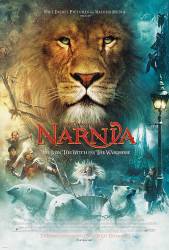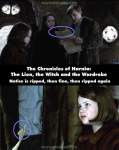Factual error: When the train is travelling away from Paddington Station, the locomotive does not have a number on the buffer beam, but has a number plate on the smokebox door. It also has a large 'British Railways' symbol on the tender. In 1940, the Great Western Railway would have had the number on the buffer beam and a either a small GWR logo on the tender or Great Western in full. British Railways wasn't created until 1948.
Factual error: During the opening WW2 battle scene, the German pilot's boots have modern Vibram soles. (00:01:00)







Answer: Spoiler alert: this gives some important plot twists away. Sometimes a bit of unresolved mystery improves a story, and I think this is the case here. But the book partly answers your questions. At the end of the last chapter it is shown that Mrs MacReady thinks the wardrobe is just a piece of furniture. She knows nothing about Narnia. But Professor Kirke amazes Peter, Edmund, Susan and Lucy by expressing familiarity with Narnia and explaining that a wardrobe might well be a portal into Narnia. If C S Lewis had not written any more books after completing "The Lion The Witch And The Wardrobe" Professor Kirke's knowledge of Narnia would probably have been an unresolved mystery. But C S Lewis later wrote "The Magician's Nephew" which tells how Professor Kirke visited Narnia as a boy. The final chapter of this book says he took an apple back with him, which he planted in his garden. It grew into a tree, was cut down and made into the wardrobe. So Professor Kirke was not consciously aware of what the wardrobe could do, but with hindsight, he realised that he had set up a chain of events that caused the children to discover Narnia.